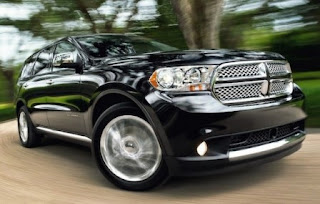
This 2011 Dodge Durango looks and feels nothing like any Durango to have come before it – and that’s no bad thing.Presumably named after the mining town-turned-tourism hub in southwestern Colorado, the Durango is a rear or all-wheel-drive unibody SUV with three rows of seats and a choice of V6 or V8 power. No mere crossover, the Durango puts the majority of its power to the rear wheels, unlike its rivals. In many ways an extended wheelbase version of the all-new Jeep Grand Cherokee, the Durango shares some of its architecture with the Mercedes-Benz M-Class. At just shy of $50,000, our Durango Citadel AWD wasn’t cheap, but it wasn’t lacking much, either.
Dodge Durango primarily square off against domestic rivals, the Ford Explorer and General Motors’ Lambda platform trio, the Chevrolet Traverse, GMC Acadia and Buick Rendezvous. Mazda Unlike its crossover competitors, the Durango offers traditional SUV grunt and towing capacity thanks to the optional HEMI V8.
For starters, no Durango looks and feels like a base model, unlike some of its rivals. Loaded with swagger, the Dodge Durango is exactly what you might expect from the automaker that also offers the Charger and Challenger. Keep going and the Grand Cherokee channels itself in the rear, where a chrome strip links the tail lights. Way bolder than its Ford and GM rivals, the Durango positively oozes style. Sexist judgments aren’t our thing here, but there’s no denying that the Durango is the man’s family hauler, especially with the chrome 20-inch wheels on the Citadel.
Citadels feature rear seat butt warmers. Unlike some rivals, the Durango’s rear seats are manually-folding, an inconvenience we don’t really find inconvenient. Our Durango was optioned up with the $1,895 HEMI V8, which packs 360 horsepower and 390 lb-ft. of torque. V6s are a more palatable 16/22 with all-wheel-drive. The fully independent suspension comes, at least in part, from the Mercedes-Benz parts bin, meaning Chrysler can thank ze Germans for the Durango’s terrific ride control. Add in decently communicative rack and pinion hydraulic power steering (not the electric setup found on rivals) and the Dodge Durango actually becomes mildly entertaining on curvy roads. Speaking of that all-wheel-drive system, the Durango offers a two-sped transfer case but no 4×2 mode. Unlike the versatile Grand Cherokee, the Durango sits fairly low to the ground – we snagged its front lip spoiler on modest hills during our photo shoot. Towing capacity blows away crossovers but doesn’t quite reach the big SUVs at 7,100 lbs.
That’s about halfway between crossovers (the Explorer is rated at 5,000 lbs.) and body-on-frame SUVs (the Tahoe can tug 8,500 lbs.).
Highway cruising is perhaps the Durango’s biggest forte.
The 2011 Dodge Durango Midsize SUVs. If you remember the Dodge Durango as a trucky, subpar family SUV, we’ve got news for you: reviewers say the all-new Durango can keep up with the pack of midsize family SUVs.
Reviewers say the 2011 Dodge Durango, which is all new, changes that. "Dodge's revamped Durango brings style and comfort to the 7-seat crossover segment,” says Consumer Guide. In short, car reviewers agree that the Durango is back, and is better than before.
While the Dodge Durango was on hiatus, the midsize SUV class got more competitive. Inside, reviewers say the Durango matches or exceeds what the competition offers. The Jeep Grand Cherokee and the Durango share a platform and some components. Most reviewers compare the Durango to the 2011 Ford Explorer, another SUV that’s all-new this year. Like the Durango, the Explorer can seat seven, rides smoothly and has a welcoming cabin. Unlike the Durango, the Explorer doesn’t have an available V8 engine.
Details: Dodge Durango
The Dodge Durango is all new for 2011. Four trims are available: Express, Crew, Crew Lux and Citadel. The Durango shares much of its architecture with the Jeep Grand Cherokee.
Like the Grand Cherokee, the new Durango sends outdated, hard-edge plastics to the recycling bin. With an engine lineup whittled to only a 3.6-liter V-6 or the HEMI 5.7-liter V-8, the Durango gets focused on superior powertrain performance, and wins the battles for acceleration, responsiveness and towing capacity. The Durango mates better with the essentially carryover five-speed automatic in the Durango than it does with Chrysler's new six-speed gearboxes. Accompanying the drive are fantastic HEMI drivetrain noises. There's none of the bounding you'd find in a Grand Caravan, which also seats seven—the Durango's heft mutes it out, even without the optional, advanced air suspension of the Grand Cherokee and the GL-Class.
Even from its side profile, the 2011 Dodge Durango looks a lot more passenger-friendly than the version it replaces. With a 119.8-inch wheelbase, the Durango is 75.8 inches wide, and has 84.5 cubic feet of cargo space behind the front seats. Inside, the Durango is notably comfortable and refined—especially for a vehicle without a luxury badge. The driving position in the Durango is excellent, with a nice, upright vantage point, and the seats are supportive and comfortable. The base Durango Express is priced just below $30,000 and includes a pretty impressive feature set; but Bluetooth is an option and upgrades like power seats, seat heating, push-button start and a power telescoping steering wheel are not offered. A top Citadel model; for about $42,000, bundles almost every option and feature including a sunroof; blind-spot monitors; adaptive cruise control; a Garmin navigation system; and a heated steering wheel.
